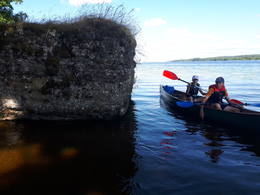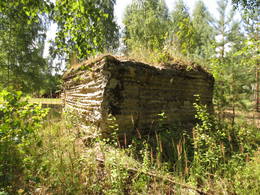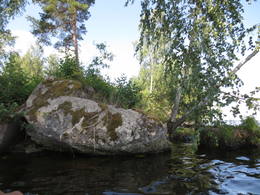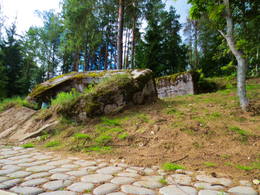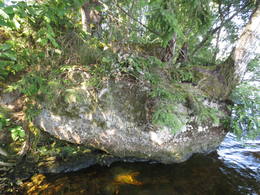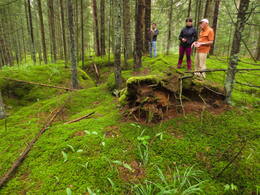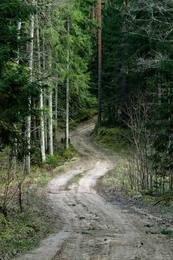Kegumo gyventojų pastangos išsaugoti elektrinę
1941 m. birželio 22 d. (sekmadienį) Latvijoje prasidėjo Antrojo pasaulinio karo įvykiai. Karo banga „praėjo“ virš Kegumo be didesnių mūšių. Sovietų armijai paskubomis traukiantis, rusų kareiviai taip pat užpuolė Tomės užmiesčio namus, norėdami gauti maisto.
Norėdami apsaugoti gyventojus, Tomės centrinėje stotyje įsteigėme apsaugos grupę su kontaktiniu punktu. Į mūsų būstinę atvyko elektrinės darbuotojas Aldermanis iš „Stutenių“ namų ir technikas su direktoriaus Krasovskio prašymu padėti išvengti numatomo elektrinės sprogimo.
Rusijos saugumo vadovybė paprašė direktoriaus P. Krasovskio ir asmens, galinčio parodyti lankytinas vietas, elektrinės plano. Tunelyje yra dinamito dėžės, reikia spėti įeiti ir nupjauti prijungtus laidus. Veikiame greitai ir atsargiai, stebėjimui naudojame Bikių sodybos palėpę.
Rusiškomis uniformomis apsirengusiems kariams leidžiama pereiti tiltą, o eiliniai sulaikomi tol, kol bus patikrinti dokumentai.
„Įsigiję“ keturių rusų kareivių uniformas, mūsų elektrinės darbuotojai įsiskverbia į didesnį būrį rusų, kurie ėjo per tiltą.
Technikas, kaip administracijos asmuo, su specialiu leidimu galėjo kalbėtis su tilto apsaugos darbuotojais. Kaip ir planavome, technikas susitiko su mūsų komanda ir jie sugebėjo įlįsti į šachtą ir nukirpti laidus. Kitą dieną technikas atvyko su P. Krasovskio padėka už tai, ką jis padarė. Mūsų informatoriai perspėjo, kad komandų poste buvo padėtas bombos paleidimo įtaisas, kuris aptiks laidų pažeidimus. Stebėjome, ar Rusijos bombonešiai aptiks žalą ir sukels pavojaus signalą. Įvykiai įsibėgėjo. Tiltą saugančius karinius dalinius pakeitė civiliais drabužiais vilkintys policijos sargybiniai (su užrašu ant rankovės). Kilo neramumai, o kelyje pasirodžius kelioms vokiečių šarvuotoms mašinoms, elektrinė liko be apsaugos. Technikui pasiūlius, savanoriais perėmėme apsaugą ir kelias dienas mūsų vyrai saugojo Kegumą. Atvažiavo P. Krasovskis su savo štabu, privažiavo vokiečių šarvuočiai ir jos vadas trumpai pasikalbėjo su vadovybe ir išvažiavo.
Iš Rygos atvyko vokiečių politinė vadovybė ir Rygos apygardos vadovas Veida. Jis asmeniškai padėkojo man ir Tomo sargybiniams už patriotišką darbą. Gavome atlyginimą, pirmuosius vokiškus pinigus Latvijoje ir iškvietimą tarnauti policijoje... Džiaugėmės, kad išpildėme pono Krasovskio prašymą ir kartu apsaugojome savo Ķegumo elektrinę.
Dabar, praėjus dešimtmečiams, suprantu to momento pavojų Kegumui ir didžiules direktoriaus Krasovskio pastangas išgelbėti mūsų elektrinę visomis išgalėmis.
Tačiau birželį, Raudonosios armijos daliniams traukiantis, bomba buvo numesta ant 80 metrų 6-ojo Kegumo tilto tarpatramio, kad kiek trukdytų Hitlerio armijai žengti į rytus. Jėgainė tęsė savo kasdienę veiklą. Per du mėnesius tiltas buvo atstatytas iki medinės konstrukcijos.
Tada žalą turėjo taisyti mano prižiūrima statybų komanda, pastatyti kopėčias ir tiltą per susprogdintą atkarpą, kad darbai galėtų tęstis. Vėliau buvo pastatytas kabantis tiltas, nes betonavimui žvyro teko atsivežti iš Birzgalės. Per šį tiltą būtų galima perkelti vieną vežimėlį. Darbo buvo daug.
Andersone, R. 2004. Kegumo hidroelektrinė. 69 psl.
Susijusi laiko juosta
Susijusios vietos
The German army's concrete fire point in the Kegum HPP reservoir near the Nega inlet
It is located in the Ķegum HPP reservoir at the Nega inlet (in front of the Nega houses), on its left bank. One of the most visually and scenically impressive and also the best-preserved concrete fireplaces, washed by the waves of the Daugava. It can be seen from a larger piece. A footbridge has been built from the shore to the top of the fire point (overgrown with grass). Narrow-gauge railway (?) tracks embedded in the concrete walls of the fire station. You can get inside from the side of the footbridge. This is one of the fire points of the defense line of the German army during the First World War on the left bank of the Daugava, which can more or less be traced along the entire length of the left bank of the Daugava. The aforementioned line of defense is a large-scale military system that has not really been evaluated as a whole until now. The remains of the fire point can be seen by boat on the Ķegum HPP.
Concrete fire point of the German army at the top of the bank of the Ķegum HPP in front of Andulii
It is located about 1.2 km east of a small extension of the stream (the stream flows near Lejasgrantiniņi) at the top of the steep bank slope of the Ķegum HPP in front of Andulii. The shore in this place is overgrown with forest and undergrowth, so only a keen observer will notice this fire point from the side of the reservoir. The fire point is well preserved as it has not been damaged by coastal erosion. This is one of the fire points of the defense line of the German army during the First World War on the left bank of the Daugava, which can more or less be traced along the entire length of the left bank of the Daugava. The aforementioned line of defense is a large-scale military system that has not really been evaluated as a whole until now. The fire point can be seen by boat on the Ķegum HPP, as it is located in a private area.
The remains of the German army's concrete fire point in the Ķegums HPP reservoir in front of Sidrabini
It is located about 0.25 km east of the Ķegum HPP reservoir bay near Silapūpēži, in the direction of Jaunjelgava, opposite the Sidrabiņi farm. The point of fire has slipped partially into the water and split into several parts, resembling a pile of construction debris. The coast is overgrown. This is one of the fire points of the defense line of the German army during the First World War on the left bank of the Daugava, which can more or less be traced along the entire length of the left bank of the Daugava. The aforementioned line of defense is a large-scale military system that has not really been evaluated as a whole until now. The remains of the fire point can be seen by boat on the Ķegum HPP. About 150 m west of the Daugava bank, the remains of another fire point have slipped into the water.
The remains of the German army's concrete fire point in the Ķegums HPP reservoir in front of Jaundauglii
It is located on the shore of the Ķegum HPP water reservoir about 0.6 km east of the Nega inlet, in front of Jaundauglii. The point of fire has slipped from the shore into the water and broken into several parts. Two larger birches have grown in it, a thicket has grown. One part of it is connected to the shore by a footbridge. This is one of the fire points of the defense line of the German army during the First World War on the left bank of the Daugava, which can more or less be traced along the entire length of the left bank of the Daugava. The aforementioned line of defense is a large-scale military system that has not really been evaluated as a whole until now. The remains of the fire point can be seen by boat on the Ķegum HPP.
Concrete fire point of the German army on the shore of the Ķegum HPP near Pudurie
It is located on the peninsula at the mouth of Konupīte (currently a flooded extension of the river) in the Daugava, in the territory of the "Puduri" recreation complex. As a result of wave erosion, the fire point has tilted towards the river. To prevent bank erosion, the banks of the reservoir here have been reinforced with a concrete protective wall. The fire points of the defense line of the German army during the First World War can more or less be traced along the entire length of the left bank of the Daugava. The aforementioned line of defense is a large-scale military system that has not really been evaluated as a whole until now. The fire point can be seen well by taking a boat along the Ķegum HPP.
The remains of the concrete fire point of the German army on the shore of the Ķegum HPP reservoir in front of Silapūpēži
It is located about 0.1 km east of the Ķegum HPP reservoir bay near Silapūpēži, in the direction of Jaunjelgava. The fire point has slipped partially into the water, overgrown with trees, bushes and other vegetation, and to the uninitiated, a larger piece from the water side may resemble a larger stone. One of the landmarks is a birch tree growing on it. This is one of the fire points of the defense line of the German army during the First World War on the left bank of the Daugava, which can more or less be traced along the entire length of the left bank of the Daugava. The aforementioned line of defense is a large-scale military system that has not really been evaluated as a whole until now. The remains of the fire point can be seen by boat on the Ķegum HPP. About 150 m east of the Daugava bank, the remains of another fire point have slipped into the water.
Possible location of Otomaras Oškalns bunker
A remote and difficult to access place - a large forest massif about 200 m west of the Nega river and about 0.5 km southwest of the Nega flood. It is recommended to go to the mentioned place on foot or by bicycle, using LIDAR maps and geographical coordinates. In the mentioned place, there is an inland dune embankment about a kilometer long (in the W-E direction) and half a kilometer wide (in the N-S direction) covered with coniferous forest. At the top of the northern and eastern slopes of the dune massif are well-preserved trenches, believed to date from the Second World War. Harijs Jaunzems (former Ķegums HPP engineer) believes that the bunker of the Red Army partisan unit formed by Otomaras Oškalns was located in this area (the exact point is unknown).
Prince Leopold Straße (Prinz – Leopold Straße)
The name of the place (road) during the First World War - "Prinz - Leopold Straße" - Prince Leopold's road. About 7 km long historical forest road or the place that started at the junction of Große Kurfürsten Damm and Kaiser Damm near the so-called Kurland Denkmal and winds through the forest towards Birzgale, connecting with the First World wartime narrow-gauge railway line: Lāčplēsis – Latgali. To the west of the road and about 2 km south of the site of the Kurland Denkmal is a First World War shooting range. Today, the Prince Leopold Road can be walked, cycled and driven (under suitable conditions). The road crosses Konupīti and the Nega tributary.
It is thought that the soldiers of the German army, staying for a long time on the front of the left bank of the Daugava, named this road after the Bavarian Prince Leopold (1846 - 1930), who led the German and Austro-Hungarian forces on the Eastern Front during the First World War.





